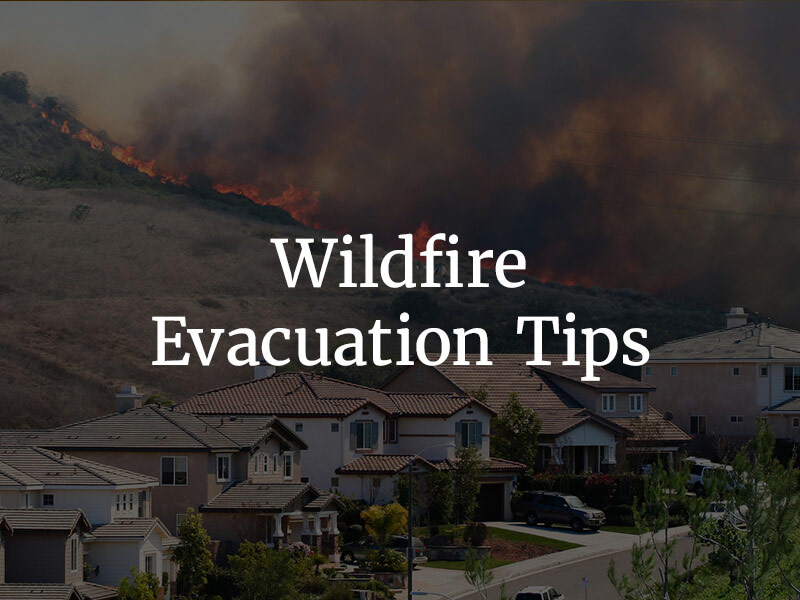Wildfire Evacuation Tips
With an average of over 5,000 blazes per year, California is one of the most dangerous states for wildfires. As a resident, it is imperative to know at least the basics of how to evacuate your home safely and efficiently during a wildfire. Taking the correct steps without hesitation is important when every second counts. Preparing yourself, your home and your family for a wildfire evacuation ahead of time could make a life-saving difference in an actual emergency.

Checklist
Preparation is key to wildfire evacuation. When a wildfire is close enough to your home to force you to evacuate, you could be too anxious, stressed or overwhelmed to think clearly in the moment. This could lead to you making critical mistakes or forgetting important things at home. Prevent these risks by printing this home evacuation checklist ahead of time. Keep it with the rest of your wildfire evacuation supplies for optimal preparedness in a fire emergency.
- Drink plenty of water to stay hydrated
- Put your emergency kit in your vehicle
- Shut all doors and windows, but leave them unlocked
- Push all furniture, along with curtains, into the center of each room
- Leave indoor lights on to help firefighters see your home through the smoke
- Turn off your HVAC system and ceiling fans
- Turn off your gas at the meter or tank
- Place combustible items in a pool or garage
Your wildfire emergency kit should contain essentials such as boxes of water, nonperishable food items, a flashlight, extra batteries, a radio, burn injury medical supplies, a map, prescription medications and copies of important documents. Only complete all items on the checklist if you have time. If you are in imminent danger, evacuate your home immediately and go to the nearest shelter without moving your furniture or worrying about your HVAC system. Your personal safety comes first. Carpool with neighbors to help reduce traffic on the roads, if possible.
Preparing Your Yard
If you have time, prepare your yard before you leave. Fill as many water buckets as you can and place them around the outside of your home. Clean the gutters and remove dead leaves from your yard. Connect your hoses to spigots for firefighters. Prop open gates. If you have them, place ladders on the corners of your structures. Turn off propane tanks and move grill appliances away from structures. Do not leave sprinklers running, as this could affect water pressure in your neighborhood. Back your vehicle into the driveway, close the windows, and pack it with your emergency kit and important belongings so you will be ready to leave in a hurry.
Animals
As soon as you realize evacuation might be an option, locate your animals. Do not wait until the last minute to round up your pets. As a fire approaches, your animals may be able to sense it and get anxious, increasing the odds of them taking off. Locate them early and keep them in pens or crates in case of a fast departure. Make sure all animals are wearing collars with identification tags, along with microchips and up-to-date pet registration. Place your pets in their carriers near your front door. Do not forget to put pet food and extra water in your wildfire emergency kit.
If you have large animals, such as horses or livestock, prepare them for transport. If you have time, find a large animal fire shelter near you and bring them there ahead of time. Moving your large animals to a safe location early, before your city orders an evacuation, could save their lives. Bring your large animals with you when you evacuate, if possible. In an emergency with no time for prior preparation or transporting large animals, open gates, pens and fences to give them a chance to outrun the fires while you evacuate.

